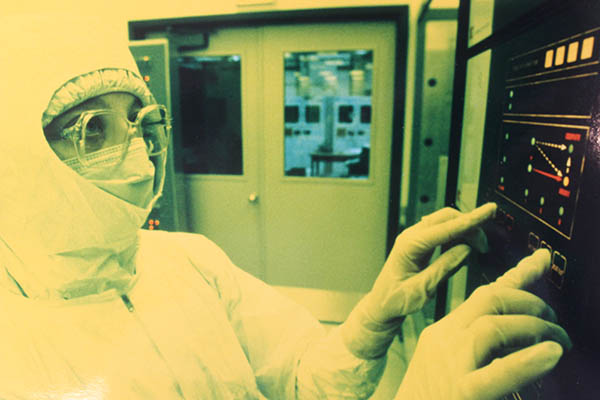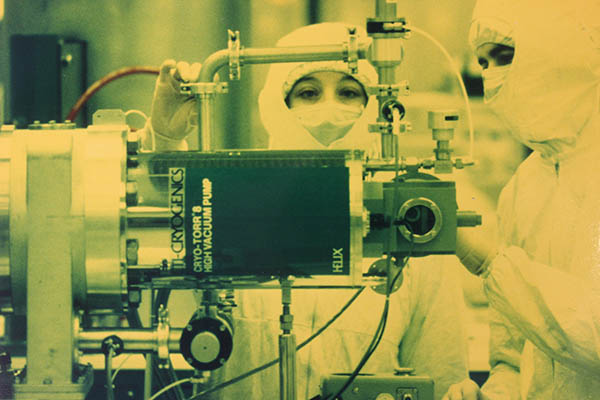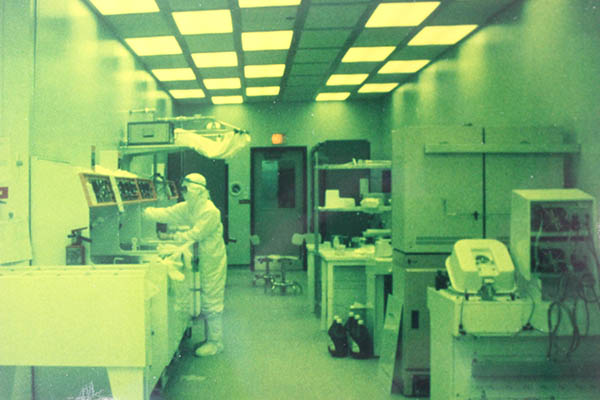Section III: 1980’s – 2017 (Department, Centers and Labs)
A New Department, Building, and Cleanroom
In 1984, Prof. Haddad, in consultation with others, received approval to bring together several programs under the umbrella of Electrical and Computer Engineering, creating the Department of Electrical Engineering and Computer Science (EECS). The new EECS Department was a merging of the existing Department of Electrical and Computer Engineering, the Computer and Communication Sciences (CCS) Department in LS&A, and the graduate program in CICE.
The degrees offered after the merger were: bachelor’s degrees in Electrical Engineering, Computer Engineering, and Computer Science; master’s and doctoral degrees in Electrical Engineering, Electrical Engineering: Systems, and Computer Science and Engineering. All of the course numbers were changed to incorporate the new emphasis on computer science. There were 61 faculty in the department roster, but that number quickly swelled to about 101 in 1988, and 130 courses offered across its different programs. Following the merger, there was an immediate boost in graduate student enrollment.
While the organization of the new department was being worked out, plans for a new building, promised as early as 1970, were finally coming to fruition. Finally, in 1983, a $30M building on North Campus was approved by the State Legislature, and ground was broken the following May. The building included 125,000 sq. ft. of offices, labs, and classrooms, as well as a 12,000 sq. ft. cleanroom facility to support research in the Solid-State Electronics Laboratory (SSEL). Two undergraduate courses were added to the curriculum in the late 1980’s that introduced students to micro and nanofabrication techniques in the SSEL: Integrated Microsystems Laboratory and Solid-State Device Laboratory.
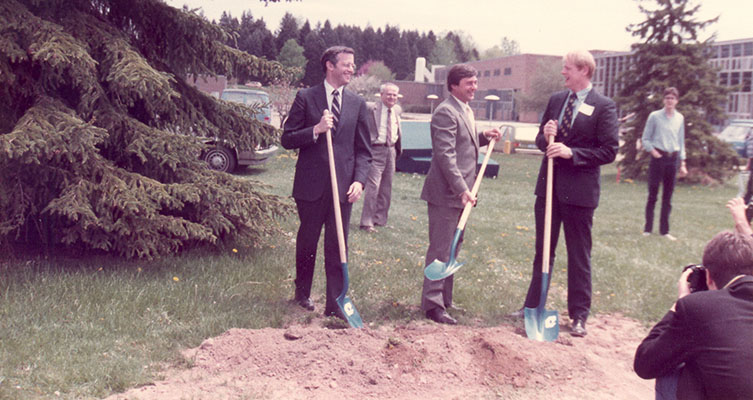
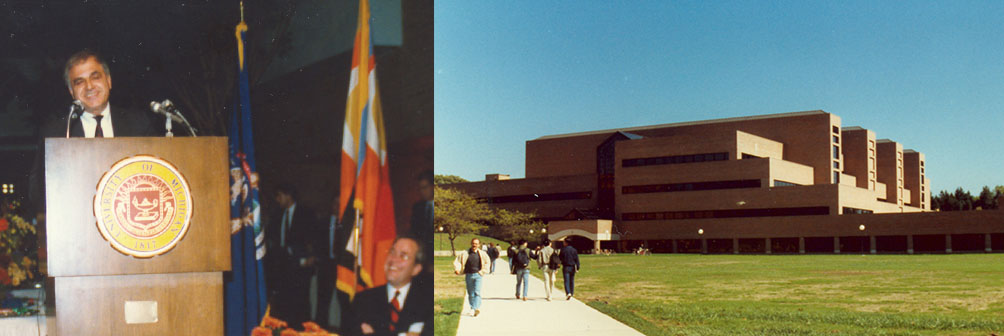
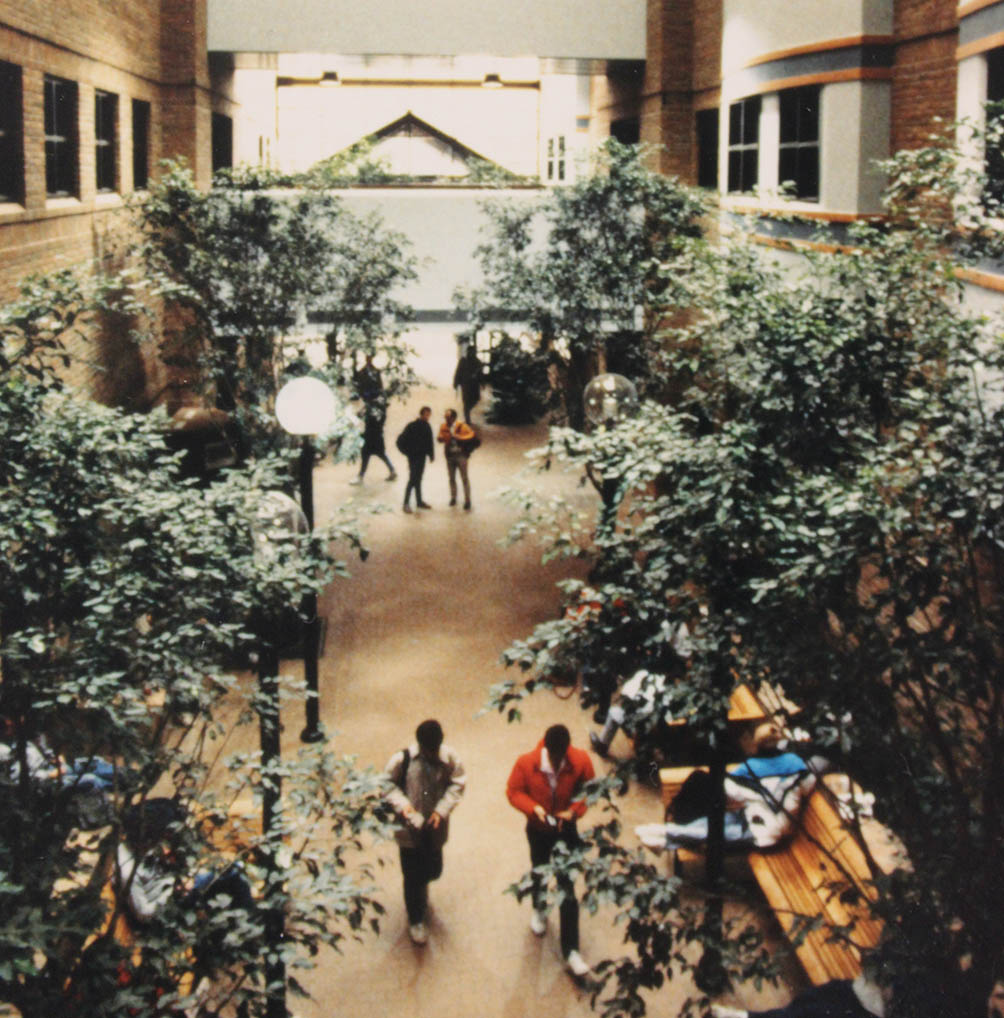
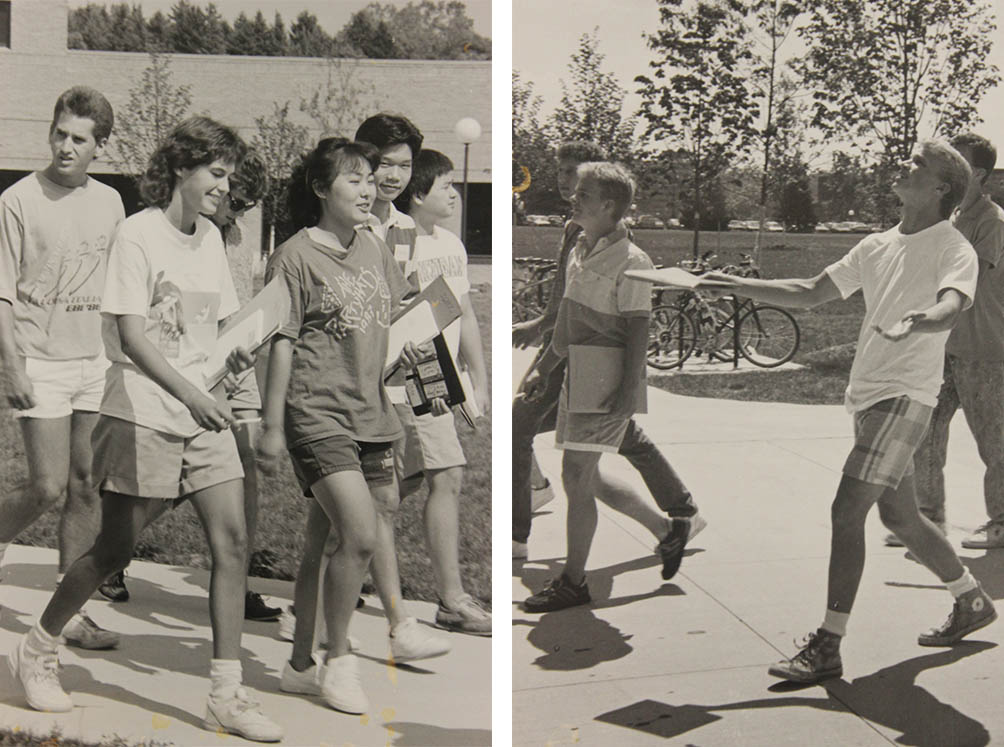
Administration and Structure (1980’s – 2017)
Before moving on to a focus on research labs, centers, and impact since the late 1980’s, it may be a good time to review some of the administrative and structural changes in the department after the merger in 1984.
Prof. Edward S. Davidson was recruited to Michigan in 1988 to be the first department chair specializing in computer science. The department had finally been able to hire a large number of new faculty, many in the area of computer science. It was time to have a department chair representing that area. Unfortunately, Davidson remained as Chair for a fairly brief time, stepping down in 1990. He would later help establish the University of Michigan’s Center for Parallel Computing in 1992.
Tom Senior stepped in for a year as Acting Chair before George Haddad agreed to serve again, as noted above. Pramod Khargonekar served as Department Chair between 1997 and 2001, stepping down to become Dean of the College of Engineering at the University of Florida. Prof. Richard Brown served as Interim Chair between 2001 and 2003, leaving to become Dean of Engineering at the University of Utah.
Under Brown’s watch, the department’s structure changed somewhat, under pressure from the Computer Science faculty for greater visibility, autonomy, and influence over policy. For the first time since 1986, there would be two official divisions, Electrical and Computer Engineering (ECE), and Computer Science and Engineering (CSE), rather than three (Electrical Science and Engineering, Systems Science and Engineering, Computer Science and Engineering). This was a bit of a compromise to avoid splitting the department – a discussion that caused such rancor faculty were happy to see it put to rest – though not for as long as some might have liked. Curriculum committees would be managed by each division, except for the undergraduate computer engineering curriculum, managed by both divisions.
Recruited to be department chair from the University of Illinois in 2003, Prof. David C. Munson, Jr. stepped down in 2006 to become Dean of the College of Engineering at Michigan. Prof. Munson had put a great emphasis on undergraduate education and departmental climate.
When Brian E. Gilchrist was appointed Interim Chair in 2006, the year the computer science faculty moved into the Bob and Betty Beyster Building, the computer science faculty again wanted to raise the issue of departmental organization. The most recent organizational changes didn’t go far enough in granting them the independence they needed to reach their goals in visibility, national standing, and self-governance.
In 2008, after much discussion, even greater autonomy was granted between the two divisions, but the department remained intact. As a compromise structure, each division would have its own chair of equal standing and with independent budgets. The two division chairs together make decisions that impact the entire department. The first Chairs of the two divisions were Khalil Najafi, Peter and Evelyn Fuss Chair of Electrical and Computer Engineering and Schlumberger Professor of Engineering, and Farnam Jahanian, both appointed in 2008. Prof. Najafi is currently serving his second term as Chair of ECE.
Given the breadth of activity that goes on just in Electrical and Computer Engineering, it’s difficult to suggest that greater autonomy was not warranted between the two divisions. One key factor in remaining one department was the stake placed in computer engineering by both ECE and CSE. The ECE division lay claim to computer engineering, and had since 1971 when it changed its name to the Department of Electrical and Computer Engineering. The computer science faculty also claimed computer engineering, so it remains a jointly-administered program by both divisions. This joint management is considered one of the major strengths of Michigan’s computer engineering program.
Following the creation of ECE as one of the two divisions in EECS, ECE continued making significant changes in its structure, in both research and educational areas. Prof. Najafi believed that ECE needed to unify many of its activities to ensure its continuing future success. Under his leadership, in 2014 the division combined its two main graduate programs in EE and EE:Systems into a single graduate program called Electrical and Computer Engineering.
In 2015, the four major labs in ECE were reorganized and nine technical areas were named in Optics and Photonics, Electromagnetics, MEMS and Microsystems, Integrated Circuits and VLSI, Control and Robotics, Signal Processing, Communications, Power and Energy, and Solid-State Devices and Nanotechnology. Each area has an Area Director elected by faculty in these areas, and staff are assigned to faculty based on proximity, rather than research area (though most often they are the same thing). This new organization is expected to facilitate collaboration among ECE faculty, something that will play an instrumental role in enhancing the multi-disciplinary research of the division.
Major Centers and Labs since 1980
Priof to the reorganization into technical areas, the ECE division had been loosely organized by different types of labs: Solid-State, Systems (control, communications, signal processing), Radiation (electromagnetics), and Optics. Two new lab groups have been added in the past decade: Power and Energy Lab, and Michigan Integrated Circuits Lab. These two are described below, as well as the Solid-State Electronics Laboratory, since it has been closely associated with major new fabrication labs, and the Radiation Laboratory, which is the only lab that still retains its name and structure as of 2017.
Major centers are generally funded because there is clear evidence that the millions of dollars spent on them will be put to good use: generating new technology, establishing new scientific principles, and educating the next generation of engineers and scientists. Michigan has an excellent legacy for establishing long-term research centers, some being the first of their kind. Following is a description of some of the major Centers and Labs since the 1980’s.
1946 – 2016: Solid-State Electronics Laboratory (and the Lurie Nanofabrication Facility)
The Solid-State Electronics Laboratory (SSEL) is one of the oldest and largest academic research and educational laboratories in the country working on semiconductor devices, integrated circuits, MEMS, and microsystems. Its history reaches back to the Electron Tube Laboratory, established in 1946 by Prof. Dow (described above). It was renamed SSEL in 1984.
From the beginning, the SSEL has always had a physical lab associated with it. The state of the lab in the 1970’s was barely adequate, yet sufficient for the technology at the time. Ken Wise remembers showing Bob Noyce, the CEO of Intel, through the lab in East Engineering. “It was not the highpoint of my career,” Ken said. Despite its deficiencies, it was like many other academic labs at the time.
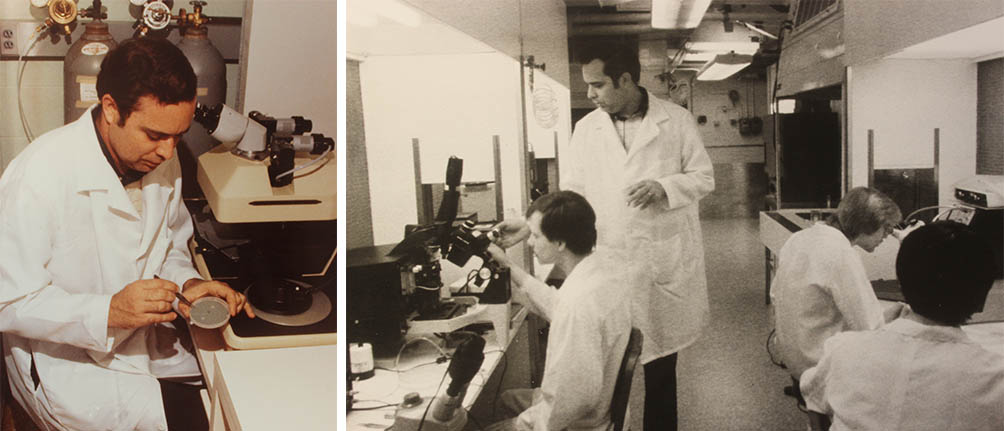
By 1980, it was clear that a new lab was essential to future successes in the area of solid-state electronics, and in particular the emerging field of micro-electro-mechanical systems (MEMS). Thanks to the support of the Dean, a new cleanroom was built alongside the EECS Building in 1984 that was on par with the few other cleanroom facilities in the country.
The Solid-State Electronics Laboratory in 1988:
The lab served the needs of the faculty well for the next 15 years or so. But by the end of the 20th century, it was clear that for Michigan to continue its state-of-the-art research in MEMS as well as other areas in solid state technology, attention must again be turned to equipment and facilities. This time, multiple Deans (Dean Steven Director, Interim Dean Ronald Gibala, and Dean David C. Munson, Jr.) stepped up to help make it happen, with the help of alumni and friends of Michigan Engineering.
Ann Lurie, long-time supporter of Prof. Ken Wise’s research, led the fundraising effort with a $15M gift. Many other generous donors contributed to the $40M expansion and renovation. Another $20M in equipment from the University completed the facility. The facility was renamed the Lurie Nanofabrication Facility (LNF), and dedicated in 2008. The existing lab staff, led by Dr. Dennis Grimard, were key to the ultimate success of the facility, as they had more experience in what was needed in the expanded lab than any consultant they could find.
Between 2004 and 2014, Michigan was a member of the National Nanotechnology Infrastructure Network (NNIN), directed by Khalil Najafi. This helped put Michigan on the map in nanotechnology. The NNIN was an integrated partnership of fourteen user facilities, supported by NSF, providing unparalleled opportunities for nanoscience and nanotechnology research. The network provided extensive support in nanoscale fabrication, synthesis, characterization, modeling, design, computation, and hands-on training to all qualified users.
The LNF, comparable to the best nanofabrication facilities in the world, is used by hundreds of students and researchers at the University of Michigan, other academic institutions, national labs and industry. While officially under the direction of the College of Engineering, ECE faculty remain the primary users of the LNF.
Through 2016, the name, Solid-State Electronics Laboratory, refered solely to an organizational unit, similar to the Radiation Laboratory, Systems Laboratory, and Optics and Photonics Laboratory. Faculty conducted research in all aspects of solid-state devices and technologies, including solid-state physics and theory, integrated photonics and optoelectronics, organic and molecular electronics, optical displays, microwave devices and circuits, semiconductor materials and metrology, nanotechnology and nanofabrication, integrated RF, analog, digital, and VLSI circuits, solid-state sensors, actuators, microelectromechanical systems (MEMS), and integrated microsystems.
1957 – – : Radiation Laboratory
The Radiation Laboratory was formally established within the department in 1957, though its roots reach back to research conducted at Willow Run in the late 1940’s, as noted earlier in a discussion of its history through the early 1980s.
The RADLAB was a target of the Progressive Student Network in the 1983, as described earlier. While their protests of defense research attracted a fair amount of attention, it did little to alter the activities in the lab.
However, just a year later the RADLAB’s fortunes improved through the hiring of three key faculty: Linda Katehi, John L. Volakis, and Fawwaz T. Ulaby. Prof. Katehi established a research program in microstrip devices and would later move into administration both at Michigan and elsewhere (most recently as chancellor of the University of California). Prof. Volakis established a world-wide reputation in scattering before returning to his alma mater, and Prof. Ulaby brought his nationally-recognized program in remote sensing.
Prof. Ulaby remained at Michigan, establishing the Center for Space Terahertz Technologyin 1988, just four years after arriving. He served as Director of the RADLAB from 1987-1998, was elected a Fellow of the National Academy of Engineering in 1995, and named Emmett Leith Distinguished University Professor in 2010.
When the Department moved into the new EECS Building in 1986, it was the first time the lab’s theoretical and experimental activities were located in the same building. A 50 ft. tapered anechoic chamber was part of the facilities, and remains to this day.
In May 1987 the Laboratory hosted the International Geoscience and Remote Sensing Symposium (IGARSS ‘87), which was attended by about 500 scientists from 21 countries. By then the main areas of research of the Laboratory were electromagnetic scattering from both manmade and natural targets, microwave and millimeter wave remote sensing of terrain and vegetation, and the computer-aided design (CAD) of microwave and millimeter wave circuits.
Research in the 1990’s focused on active and passive remote sensing of terrain and vegetation, design and fabrication of microwave and millimeter wave antennas and devices, computational electromagnetics, and scattering by natural and man-made objects. The faculty were recognized as world leaders in their respective areas, receiving the highest honors in their field while Prof. Senior served as president of the International Union of Radio Science (URSI). In addition, five textbooks were published. In 1993 the Laboratory hosted the IEEE AP-S International Symposium and URSI Radio Science Meeting with almost 1000 participants.
Kamal Sarabandi (MSE PHD EE 1986 1989; MSE Math 1989) was hired in 1992, and became Director of the RADLAB in 2000. He studied under Prof. Ulaby, continuing and expanding research in microwave remote sensing, with a special focus on antennas. He established the Center for Objective Microelectronics and Biomemetic Advanced Technology (COMBAT) in 2008.
New areas of research in applied electromagnetics that continue to this day were initiated with the hiring of Eric Michelssen and Anthony Grbic. Michielssen, Louise Ganiard Johnson Professor of Engineering, specializes in computational electromagnetics. He was named Associate Vice President for Advanced Research Computing and Director, Michigan Institute for Computational Discovery and Engineering in 2013. Grbic, Ernest and Bettine Kuh Distinguished Faculty Scholar, expanded research into metamaterials, planar antennas, wireless power transmission, and optics.
Prof. Ulaby served as U-M Vice President for Research from 1999 to 2005, and followed that by becoming the Founding Provost of the King Abdullah University of Science and Technology (KAUST) in 2008. He then rejoined the RADLAB faculty the following year and continued his legacy of nearly unmatched teaching of undergraduate students.
Prof. Mark Kushner, former Dean at Iowa State University, joined the RADLAB and Michigan in 2008. He was immediately named inaugural Director of the Michigan Institute for Plasma Science and Engineering (MIPSE), and received the title, George I. Haddad Professor of EECS. Within a year, he brought a $10M Department of Energy Center to Michigan, called the Center for Predictive Control of Plasma Kinetics: Multi-phase and Bounded Systems.
As of 2017, the RADLAB offered more than fourteen graduate courses in RF engineering and electromagnetics covering a wide range of analytical, experimental, and numerical topics. Faculty and staff perform research in all aspects of applied EM, including Microwave and Millimeter-Wave Circuits, MEMS Circuits, Antennas, Wave Propagation Studies for Wireless Applications, Scattering, Computational Electromagnetics, Active and Passive Microwave Remote Sensing, Plasma Electrodynamics, and EM Metamaterials.
It was equipped with a variety of state-of-the-art microwave and millimeter-wave test equipment, two anechoic chambers, near-field and far-field antenna measurement systems, EMC/EMI testing facilities, microwave and millimeter-wave fabrication facilities, polarimetric radar systems covering 0.1–210 GHz, and extensive computational facilities.
1986 – 2001: Center for High-Frequency Microelectronics (CHFM)
The Center for High-Frequency Microelectronics advanced the state-of-the-art in electronic and optoelectronic materials, devices, and integrated circuits. Founded in 1986 by George Haddad, it was one of the first DoD-funded University Research Initiatives (URI).
The Center focused on compound semiconductor materials, devices and integrated circuits. In particular, emphasis was placed on GaAs- and InP-based materials and their applications in high frequency diodes and transistors, lasers, monolithic microwave integrated circuits, and digital circuits.
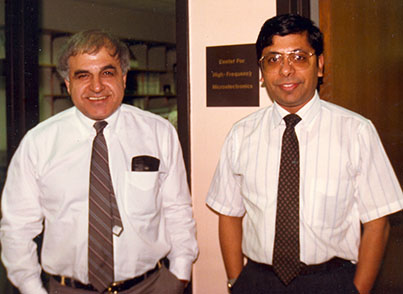
Significant and ground-breaking results were obtained in all these areas, including Field Effect Transistors (FETs), High Electron Mobility Transistors (HEMTs), Heterojunction Bipolar Transistors (HBTs), Quantum Well (QW) and Quantum Dot (QD) Diodes for laser and detector applications, Resonant Tunneling Diodes (RTDs) for millimeter-wave sources and digital circuit applications, millimeter-wave integrated circuits for amplifiers, oscillators and detectors, integrated optoelectronic receivers and complementary digital circuits. This technology is widely employed in low-noise receivers and used in communication and radar systems, wireless communication transmitters, and optical communication systems. Additional information about the quantum dot technology and devices is found in the section below on Lasers, Lighting, and Quantum Dots.
In addition to research, the Center supported equipment and facility upgrades, which have been critical to future innovations. Over its duration, the Center’s funding was approximately $30M ($25M from the Army and $5M from the State of Michigan Research Excellence Fund).
1987 – 2000: Center for Integrated Sensors and Circuits (CISC) and Program in Automated Semiconductor Manufacturing
Ken Wise, William Gould Dow Distinguished University Professor, founded and directed the Center for Integrated Sensors and Circuits (CISC), which was renamed Center for Integrated Micro-Systems (CIMS) in 1998. The Center was formed to foster increased interaction among the many individuals at the University of Michigan engaged in research on sensing, data acquisition, advanced signal processing, and sensor-driven adaptive control. It was one of the major worldwide efforts in the development of new integrated sensors and data acquisition circuits.
There were two major contracts in existence when the center was created. As part of the National Institutes of Health (NIH/NINDS) Neural Prosthesis Program, faculty were developing electronic interfaces to the brain. The NIH program would expand under the Center from a single contract in 1981 to four contracts in the early 90s, and lead to pioneering work on neural interfaces, now a worldwide effort. The first of these programs ran 25 years, ending in 2007.
The second major research activity was the Program in Automated Semiconductor Manufacturing, funded by the Semiconductor Research Corporation (SRC) during the years 1984-1998. Michigan was one of three “anchors” of the program, along with Stanford University and the Microelectronics Center of North Carolina. In this program, faculty were developing sensor-driven control for automated semiconductor manufacturing tools. Faculty in the solid-state area and control systems area participated in the program. The program became an SRC Center of Excellence in the late 80s. According to Prof. Wise, this program had a key influence on the lab’s capabilities even to the current day.
During the late 80s and early 90s, CISC was very probably the best-funded and most productive academic sensor activity in the world. A systems-level approach was taken by CISC when most other academic sensor activities were focused at the material and device level.
For a summary of the many technological breakthroughs accomplished in this area, see the section below on MEMS and Integrated Microsystems.
By 2000, CISC/CIMS had produced over 250 archival journal articles and major conference papers, and 75 doctoral dissertations. It served as the launching pad for the NSF-funded Engineering Research Center for Wireless Integrated MicroSystems (WIMS), which expanded previous activities by merging sensor development with major efforts on ultra-low-power integrated circuits and wireless interfaces.
1988 – 1998: Center for Space Terahertz Technology (CSTT)
The NASA Center for Space Terahertz Technology was among the first of its kind in the country. Directed by Fawwaz Ulaby, the Center pioneered the development of Terahertz antenna arrays, sources, and circuit components, and supported research activities in the general areas of solid-state electronics, electromagnetics, and space remote sensing. It was one of nine university-based Space Engineering Research Centers formed that year by NASA.
The goal of the research was to explore the terahertz region of the electromagnetic specturm, which lies between the microwave and infrared regions, by developing sources, low-loss transmission lines, passive and active circuits, measurement tools, and antenna arrays.
More specifically, CSTT research included the development of fundamental oscillators, SIS mixers, Schottky mixers, frequency multipliers, antennas and antenna arrays, matching networks, IF spectrometers, electronic switches, couplers, and many associated technologies.
Although the Center’s program was not intended to be closely coupled to a specific NASA mission or space instrument, its technical direction and scientific objectives were defined to match NASA’s objectives in advancing its astrophysics and Earth Observing Systems (EOS). The Center collaborated with NASA in the design and construction of high sensitivity receivers for making spectroscopic observations from satellite platforms.
Among the new faculty hired during this time was Anthony W. England, a former Space Shuttle astronaut for NASA.
The Center helped create international forums for research in THz technology. These included the publication of special issues of scientific journals dedicated to this subject, and the establishment of the Symposium on Space Terahertz Technology (now the International Symposium on Space Terahertz Technoloyg (ISSTT)), which was first convened in Ann Arbor in 1990. Before 2000, devices to generate, control, and detect THz signals, and industrial applications of THz technology were non-existent. Today, THz technology is used in many medical, military, and industrial applications.
The Center generated 122 papers and 142 symposia presentations. Its $13M in funding supported about 10 faculty, and contributed to the support of 41 graduate students, 32 of whom received doctoral degrees.
1991 – 2001, and 2001 – : Center for Ultrafast Optical Science (CUOS)
The Center for Ultrafast Optical Science (CUOS) was established as a Science and Technology Center by the National Science Foundation in 1991, and was directed by Gérard A. Mourou. Its mission has been to perform multidisciplinary research in the basic science and create technological applications of ultrashort laser pulses, to educate students from a wide variety of backgrounds in the field, and to spur the development of new technologies.
CUOS researchers have developed optical instrumentation and techniques to generate, manipulate, and detect ultrashort and ultrahigh-peak-power light pulses. They have used these ultrashort pulses to study ultrafast physical phenomena in atomic, nuclear, plasma, and materials physics, in solid-state electronics, in high-energy-density physics, and in biomedicine.
Ultrashort laser pulses are the shortest controlled bursts of energy ever developed. Optical pulses of a few femtoseconds (10-15 seconds) duration can be used to probe the fastest events in atomic, molecular, biochemical, and solid state systems. When amplified to even modest energies using chirped-pulse amplification, such short pulses can achieve the highest peak powers.
The HERCULES laser at CUOS holds the world record for on-target laser intensity, at 1022 watts per square centimeter. Ultrashort-pulse fiber lasers enable the highest average powers (100-Watt level) available from pulsed laser systems. CUOS researchers not only pioneered the development of high-peak-power and high-repetition-rate ultrafast lasers, they also led the development of numerous applications across many fields of science and technology. These include the development of high speed optoelectronics devices, light channeling, ultraprecise micromachining, femtosecond eye surgery, relativistic optics and plasma physics, electron and proton wakefield acceleration, x-ray generation, and others.
Five companies were started by CUOS scientists. These are: Picometrix (fast measurement instrumentation, Steve Williamson and Janus Valmanis), Clark-MXR (scientific lasers and micromachining, Philippe Bado), Translume (waveguide optics, Philippe Bado), Intralase (precision surgery, Ronald Kurtz and Tabor Juhasz), and Opteos, Inc. (John Whitaker with Kyoung Yang and Linda Katehi).
CUOS has also attracted companies to Ann Arbor such as IMRA-America, which has become a leading company in short-pulse fiber lasers. These companies have created numerous high level jobs and developed an ultrafast-optics-based industry with Ann Arbor as its hub. This new industry attracts outstanding scientists to Ann Arbor and benefits from the high-quality students trained at CUOS.
The original Center’s $33M in NSF funding enabled the training of more than 100 Ph.D. students. In 2001, CUOS was restructured as an interdisciplinary research center in the College and is funded through a variety of sources, including the NSF FOCUS Physics Frontiers Center. Ted Norris served as director until he stepped down to direct the new research center C-PHOM.
Since 2001, two additional companies were founded by CUOS faculty: Arbor Photonics, LLC, co-founded by Almantas Galvanauskas, and Graphene Vision, LLC, co-founded by Ted Norris.
1994 – 2006: Center for Neural Communication Technology (CNCT)
The Center for Neural Communication Technology was originally funded by the National Institutes of Health/National Center for Research Resources. David J. Anderson was Director, and Ken Wise was Primary Co-investigator. Jamille F. Hetke led the CNCT Service Program.
The CNCT was tasked with distributing Michigan’s innovative silicon-substrate microelectrode technology probes to neuroscientists funded by NIH and providing training in their use. At the same time, research was conducted on enhancements of the technology such as fluidics and reliable chronic implant systems. The biology of brain tolerance to chronic implant systems was also a critical component of the research.
Anderson led one of the research projects and conducted a seminar each year at the annual meeting of the Society for Neuroscience. Kensall D. Wise’s MEMS research pushed the envelope in many aspects of neural probe technologies. Jamille F. Hetke led the probe engineering and distribution that ultimately reached 150 neurophysiology laboratories world-wide.
The Center earned an international reputation in the design, fabrication, and experimental use of microscale MEMS-based neural probes. CNCT’s success hinged on service and training programs aimed at designing devices that met the diverse application requirements of Center participants and then providing devices to these users.
During its initial phase, the Center developed the first widely available microscale silicon multichannel probes, which opened up new dimensions in neurophysiology. Among these are functional neural mapping, sink/source analysis, and population coding. The signature CNCT technology was a family of silicon probes packaged for use in acute (single-session) experimental preparations. At the same time, the Center’s research enabled crucial progress in the development of first-generation chronically implanted probes for neural recording.
In 2006, the CNCT was moved to the Biomedical Engineering Department, directed by Prof. Daryl R. Kipke, who worked on the probes as a graduate student. Anderson and Kipke are co-founders of NeuroNexus Technologies, a startup company founded in 2004 to continue building and disseminating the neural probes.
1996 – 2001: Low-energy electronics design for mobile platforms
The MURI entitled, Low-energy electronics design for mobile platforms, was directed by Prof. Wayne Stark and funded by the Army Research Office. Eleven additional faculty contributed to this project.
In this multidisciplinary effort the team of researchers developed a novel integrated design methodology suitable for a wide range of wireless, mobile systems for low energy communications. The methodology takes into account several key subsystems, including the antenna, power amplifier, modulation, error control coding, and network protocols. The research led to increased understanding of the fundamental limits in terms of energy efficiency and bandwidth efficiency in wireless networks.
The MURI also contributed to related research efforts. These included the investigation by Prof. Stark of important coding techniques in wireless environments, research in high data rate communication in mobile environments from a signal processing perspective by Prof. Al Hero, and research in discrete event systems applied to decentralized communication systems by Prof. Stéphane Lafortune.
Prof. Stark received the MILCOM Technical Achievement Award for this and other research in 2002.
1998 – 2003: Adaptive Optoelectronic Eye
This MURI, directed by Prof. Pallab Bhattacharya, Charles M. Vest Distinguished University Professor; James R. Mellor Professor of Engineering, was highlighted by the Department of Defense in 2014 as among the most successful of the 600 awarded since its inception. The goal was to develop a versatile image sensor technology that would mimic the functions of the human eye—a technology that merged advances in optoelectronics with adaptive micro-optics and micromechanical components.
As noted in the publication, DoD’s Multidisciplinary University Research Initiative (MURI) Program: Impact and Highlights from 25 Years of Basic Research, “Key components that have had an important and lasting impact on the field of optoelectronics were the development of a new class of solid-state lasers and light-emitting diodes (LEDs) based on microcavities with embedded quantum wells and quantum dots. These high-performance devices are the basis of current photo transceivers that are used pervasively in our optical communication networks. In fact, the incorporation of quantum dots in the laser microcavity was a crucial development that lowered the threshold and also raised the efficiency and gain of these solid-state lasers and concomitantly LEDs.”
2000 – : NSF Center for Wireless Integrated MicroSystems (WIMS), and WIMS2
The NSF Engineering Research Center in Wireless Integrated MicroSystems (WIMS), founded in 2000, was directed by Prof. Ken Wise, with Prof. Khalil Najafi acting as Deputing Director. The Center partnered with Michigan State University and Michigan Technological University. It was the first-ever Engineering Research Center in Wireless Integrated Microsensing and Systems.
Building on past work at Michigan in the area of integrated sensors, the Center focused on devices capable of measuring a variety of physical parameters, interpreting the data, and communicating over a bi-directional wireless link, merging efforts in micropower electronics, wireless communications, micro-electromechanical systems (MEMS), innovative power sources, and advanced packaging. The WIMS Center was an early leader in combining wireless sensing with embedded low-power circuits. The microsystems ranged from 10cc-20cc (size of a small calculator) to less than 1mm3.
Wireless integrated microsystems are expected to become pervasive during the next two decades in applications ranging from health care to environmental monitoring, homeland security, and defense. It will make the automated gathering of information a reality, extending the electronic connectivity represented by personal communications and the worldwide web to information provided directly by the environment.
WIMS moved beyond components to the system level, creating full microsystems. Faculty in the center have developed neural interfaces, smart stents for improved cardiovascular care, biopsy needles capable of measuring local tissue density as an aid in diagnosing cancer, intraocular pressure sensors for treating glaucoma, thin-film-based cochlear electrode arrays for restoring hearing to the deaf, hand-held breath analyzers for detecting the biomarkers of tuberculosis and lung cancer, wristwatch-size radiation detectors for ensuring the safety of containerized shipping, air-quality monitors for protecting the global environment, and a microcontroller that operates at less than 1V, dissipates only 350µW at 1MHz, and contains an embedded digital signal processor executing the Continuous Interleaved Sampling speech-processing algorithm at record low power levels.
Between 2000 and 2010, WIMS researchers published more than 1,100 journal articles and conference papers; educated more than 2,100 K12 students; introduced several new courses related to MEMS and Microsystems, formed collaborations with researchers around the globe; graduated more than 150 PhD students; published 59 patents; and spun-off 12 companies. An SRI study funded by the NSF estimated the impact of the ERC on the State of Michigan alone through seven years at $256M; through ten years, that impact is estimated at over $400M.
When the funding ended in 2010, the center was renamed the Center for Wireless Integrated MicroSensing and Systems (WIMS2), and Yogesh Gianchandani became Director.
2008 – : The Center for Objective Microelectronics and Biomimetic Advanced Technology (COMBAT)
The Center for Objective Microelectronics and Biomimetic Advanced Technology (COMBAT) was established in 2008, and is directed by Kamal Sarabandi, Rufus S. Teesdale Professor of Engineering. The Center is funded by the US Army Research Laboratory, and includes UC-Berkeley and the University of New Mexico as research partners.
The goal of the Center is to conduct research in novel electronic circuit architectures and materials for enabling an ensemble of collaborating mobile micro-scale robotic platforms. The five major thrust areas of research are: novel electronic circuit processing architecture; novel materials for communication and power-efficient sensing; low-power communication and networked response; assisted and autonomous navigation; and power generation and management.
Major advancements in all five major areas have been accomplished. In the power area an advanced power source that uses evaporation has been demonstrated for the first time. Also, ultra-thin (~1µm) flexible photovoltaic cells with efficiencies in excess of 20% have been fabricated and are being integrated on the surface of the robots for mission endurance. In the area of communication, low-power digital firmware radios with tunable RF front-end, novel micro-radio repeaters with sub-wavelength dimensions (enabled by metamaterial bandgap structures) for low-power network connectivity in harsh propagation environments have been demonstrated. Miniaturized low-profile antennas that can transmit purely vertical polarization and structurally embedded antennas for small robotic platforms have been reported. Navigation systems based on a large array of hair-like structures integrated with CMOS sensors as well as a beam steerable 240 GHz imaging radar for navigation and collision avoidance in the dark and smoke are under development. Miniaturized low-power gas chromatograph with detection sensitivities as low as parts per billions for detecting chemical traces in air and a micro-Geiger nuclear trace detection having less than a 1cm3 in volume have been fabricated and successfully demonstrated. Very low power customized computational engines based on sub-threshold CMOS architectures are being developed to allow data-parallel high-throughput calculations for navigation, communications, sensing, and actuation.
The Microelectronic Center (COM-BAT) supports about 18 faculty members and more than 25 doctoral and postdoctoral students per year.
The center is one of four that the Army launched under the Micro Autonomous Systems and Technology (MAST) Collaborative Technology Alliance (CTA) to work toward this vision of small, ground (crawlers and rovers) and air (flapping, rotary, and fixed wings) robotic platforms that could sense and communicate. Each of the four centers (Microelectronics, Micromechanics, Processing for Autonomous Operation, and Platform Integration) is charged with developing the fundamental science and technology of different aspects of micro autonomous systems. This activity has enabled collaborative efforts among industry, academia, and the Army Research Laboratory.
2008 – : Michigan Power and Energy Lab (MPEL)
In the mid 2000’s, a decision was made to revitalize the Power area of Electrical and Computer Engineering, which had been phased out in the 1980’s due to lack of government funding and general interest. With the rise of sustainable energy and concerns about the protection of our environment, there has been a renewal in governmental programs that address this area, as well as a dramatic increase in students interested in this area.
Ian Hiskens, Vennema Professor of Engineering, was hired in 2008 to grow this area. Hiskens brought extensive practical and academic expertise to the area of power system analysis, with direct applications to the integration of sustainable energy sources with the existing grid. He is an expert in nonlinear systems and control.
As of 2015, this area is represented by Hiskens, Heath Hofmann (power electronics and systems), and Johanna Mathieu (modeling, estimation, and control of electric loads and storage; operational and control strategies that reduce the environmental impact, cost, and inefficiency of the power system).
2008 -: Michigan Institute for Plasma Science and Engineering (MIPSE)
The Michigan Institute for Plasma Science and Engineering (MIPSE), directed by Mark Kushner, George I. Haddad Professor of Electrical Engineering and Computer Science, is a community of faculty, staff and students at the University of Michigan and Michigan State University whose research and education programs are devoted to the advancement of the science and technology of plasmas. The research spans laser produced plasmas for particle acceleration to plasmas in the earth’s magnetosphere, with specialties in low temperature plasmas (LTP) and high energy density plasmas (HEDP).
MIPSE serves as a focal point for university-wide activities in plasmas. It provides opportunities for faculty to collaborate across disciplinary boundaries, and is committed to seeding research activities to attract center-level funding. It provides educational opportunities through a graduate certificate program.
2009 – : Energy Plasma Science Center
The Center for Predictive Control of Plasma Kinetics: Multi-phase and Bounded Systems, directed by Prof. Mark Kushner, is funded by the U.S. Department of Energy Office of Fusion Energy Sciences. The Center enables fundamental research on low-temperature plasmas, which are ionized gases with vast potential for practical technological advancements.
In particular, the Center is investigating techniques to customize the distributions of charged particles (electrons and ions) in these plasmas. A vast array of modern technologies, including renewable energy sources, lighting, microelectronics, and medicine, would not exist in the absence of low-temperature plasmas. The fundamental research that is being conducted at the Center could lead to more efficient solar cells, finer-featured microchips, and new medical tools that cut and heal tissues with plasma-activated chemistry.
The Center is a unique collaboration between nine universities and two national laboratories, involving 21 co-principle investigators. At Michigan, faculty members represent units across the university, including physics, engineering, space science and mathematics.
2011 – : Center for Photonic and Multiscale Nanomaterials (C-PHOM)
The NSF Center for Photonic and Multiscale Nanomaterials (C-PHOM), directed by Ted Norris, Gérard A. Mourou Professor of EECS, is the first Materials Research Science and Engineering Center based at Michigan.
Research is focused on controlling how light interacts with matter on all length scales, from nano up to the scale of the wavelength. C-PHOM has two primary research focuses as well as a third area devoted to financially supporting new research directions.
Prof. Bhattacharya leads the area concentrating on wide-bandgap nanostructured materials for quantum light emitters using Indium Gallium Nitride (InGaN). These materials can be used to generate blue, green, and possibly even red light emitters – and contain the promise of new and highly efficient devices. Also included in this research are Rachel Goldman (Materials Science and ECE), P.C. Ku, Jamie Phillips, and Duncan Steel.
Roberto Merlin, Peter A. Franken Professor of Physics and EECS, leads the second research area, which is focused on advanced electromagnetic metamaterials and near-field tools. A metamaterial is an artificial material made up of nano-sized particles that are engineered to take on properties not possible with natural materials. Part of this research involves studying the nonlinear optical properties of the nano building blocks that will create the materials. This research thrust includes Anthony Grbic, Jay Guo, and John Schotland (Math and ECE).
Participating institutions include Purdue University, University of Texas at Austin, University of Illinois Urbana Champaign, Wayne State University, and City College of CUNY. The establishment of C-PHOM provides a focus for Michigan’s leading efforts in nanoscience and optics, and together with CUOS positions Michigan as one of the leading universities worldwide in these areas.
2011 – : Value-centered information theory for adaptive learning, inference, tracking, and exploitation
The research program called Value-centered information theory for adaptive learning, inference, tracking, and exploitation, directed by Al Hero, R. Jamison and Betty Williams Professor of Engineering, is a Multidisciplinary University Research Initiative (MURI). Prof. Raj Nadakuditi is an investigator on the project.
This program has the goal of laying the foundation for a new systems information theory that applies to both general controlled information gathering and inference systems with mission planning, while accounting for the value of information. This new theory will be applied to current and next-generation sensing systems, which are inundated with diverse and high volumes of data.
Michigan is partnering with MIT, Ohio State University, UC-Berkeley, UCLA, UC-San Diego, and Arizona State University.
2011 – : Michigan Integrated Circuits Laboratory (MICL)
The Michigan Integrated Circuits Laboratory (MICL) is directed by Prof. Dennis Sylvester. It was founded by Prof. Sylvester in 2011 as a “spinoff” from the Solid-State Electronics Laboratory. Faculty in this area are worldwide leaders in VLSI Circuits and Systems. During the past eight years, they have published the most papers of any single institution at the two leading circuits forums, with topics ranging from image sensors to bio circuits, with a particular specialty in low power circuits.
MICL brings together researchers with expertise in a range of circuit and system design issues, with particular emphasis on building pioneering demonstration systems in emerging application areas. The faculty are investigating very-large scale integrated (VLSI) digital circuits, analog and mixed-signal circuits, wireless/radio-frequency (RF) circuits, as well as sensing systems built out of these components.
Supplementing this fundamental circuit design research, they participate in numerous major research centers, which often have a large system-building (testbed) component. Participation in these research centers, funded by NSF, NIST, DARPA, and the Army among others, allows MICL faculty to interact with application researchers as well as experts in other engineering domains. Applications of particular focus include implantable medical devices and energy harvesting-based systems.
2013 – : Dynamic Cyber-Physical Systems
The program, Dynamic Cyber-Physical Systems (CPS), is directed by Jessy Grizzle, Elmer G. Gilbert Distinguished University Professor and Jerry W. and Carol L. Levin Professor of Engineering. It is funded by NSF CPS Frontiers, and includes the research partners, Texas A&M University, UCLA, and Carnegie Mellon University.
The program addresses highly dynamic Cyber-Physical Systems (CPSs). These are systems where a computing delay of a few milliseconds or an incorrectly computed response to a disturbance can lead to catastrophic consequences. The vision of the project is to provide a methodology that allows for complex and dynamic CPSs to meet real-world requirements in an efficient and robust way through the formal synthesis of control software. The research has broad applications to automotive safety systems, prostheses, exoskeletons, aerospace systems, manufacturing, and legged robotics.
2014 – : Center for Dynamic Magneto-Optics (DYNAMO)
The Center for Dynamic Magneto-Optics, directed by Prof. Stephen Rand, was officially launched in 2014 as a Multi-University Research Initiative (MURI) by ONR/DOD. It is a five-year, $7.5M program.
Its main focus is to provide a better understanding of phenomena driven by the magnetic field component of light. Optical magnetization has received growing attention in the last few years due to its growing relevance to emerging fields like spintronics, quantum information science, optomagnetic data storage, and transformation optics. Long-term goals of the Center include investigation of mechanisms for magnetic field generation with moderately intense light, and evaluation of the prospects for direct conversion of light to electricity without the thermodynamic losses typical of photovoltaic technology.
DYNAMO supports investigations of intense magneto-optic phenomena with relevance to electromagnetic energy conversion, Terahertz generation, and high frequency (optical) magnetism. New methods are being developed to convert light directly to THz radiation or electricity, to induce large magnetic fields in normally non-magnetic materials, to induce harmonic generation by magneto-electric means, and to explore connections between relativistic and non-relativistic optical phenomena.
Michigan is partnering with Northwestern University, Columbia University, and the University of Central Florida, as well as international collaborators.
 MENU
MENU 

